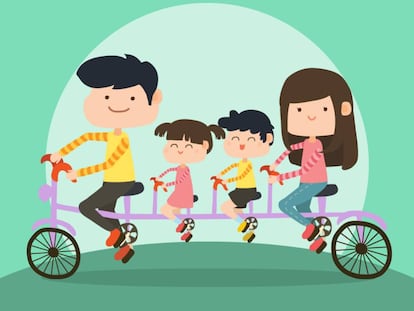Chickpeas or cookies? The problem with Spanish children’s sugary breakfasts
Families are opting for the easy-to-eat, sugar-packed products that crowd the supermarket shelves, to the detriment of youngsters’ health

Never did nutritionist María Merino, author of the blog Comiendo con María (Eating with María), think that a tweet about her son’s breakfast was going to go viral. But a picture of her child with the caption: “My son doesn’t know what a cookie is. He is happy to start the day with a bowl of chickpeas” was enough to spark a fierce Twitter debate about breakfast nutrition, with many users defending giving their children cookies for breakfast. Indeed, many people still wrongly believe that pulses are synonymous with obesity, associating them with the fatty cocido stew from Madrid, or Asturias’s own fabada stew – even though nutritionists have been saying for years this isn’t the case.
Despite what most people think, Spanish children are eating bad breakfasts. The fact that we are still surprised when we hear about a child who does not start the day with chocolate milk and cookies is a clear sign that there is a lack of information when it comes to nutrition. This much is evident from obesity statistics and data on sugar consumption.
Chocolate milk, chocolate spreads, baked goods, processed fruit juice and sugary cereals have turned breakfast into a terrible meal
Silvia Romero, dietician
Dietician Silvia Romero, who specializes in children’s nutrition and obesity and has a blog called Equilibra’t, believes that the processed-food industry is to blame for these unhealthy breakfasts. “Chocolate milk, chocolate spreads, baked goods, processed fruit juice and sugary cereals have turned breakfast into a terrible meal,” she says.
Pediatrician Carlos Casabona, a specialist in children’s nutrition and author of You choose what you eat, agrees. After years of observing what children who pass through his clinic eat for breakfast, he wrote about it on his blog, where he discussed how we have accepted cookies, which have “zero nutritional interest,” as a normal product to eat on a daily basis. “Parents opt for quick and easy solutions, such as chocolate milk or sugary cereals, and which the industry has shoved onto shelves and into the faces of their children,” he explains.
Unhealthy food: the new normal
For Casabona, the main issue is that children’s breakfasts have not evolved: “They haven’t changed in 25 to 40 years, ever since people discovered the family-sized packs of cookies.” He calls these oversized products “obesogenic packages” rather than “money-saving packages” because, in his opinion, having a great quantity of an unhealthy product at home means that you will eat more of it than if the packaging was a normal size.
My son doesn’t know what a cookie is. He is happy to start the day with a bowl of chickpeas
María Merino, nutritionist
From the US, Spain not only imports a good amount of unhealthy foods, like the breakfast cereals that Casabona mentioned earlier, but also marketing techniques that include catchy slogans and jingles. These have dug their way into family households and survived over the years, sending the same message to generations of children and their parents.
For Silvia Romero it is precisely this kind of advertising, along with “the recommendations of poorly informed health experts, the current Spanish food pyramid, guarantees issued by food associations, nutritionists and pediatricians with a conflict of interest, and a lack of food-health education,” that have contributed to the normalization of certain unhealthy products such as cookies, cupcakes and highly processed cereals, which are made to look healthy when in reality “they shouldn’t form part of children’s diets at all.”
Is breakfast that important?
Julio Basulto, a dietician, said it in the last chapter of his book Se me hace bola. Cuando no comen como queremos que coman (or, I can’t swallow it down. When they don’t eat the way we want them to) dedicated to the picky eater: “Breakfast is not the main meal of the day.”
Basulto cited a 2012 article published by María Manera Bassols, a dietician specializing in children’s nutrition, in which she picked apart the concept. For Manera, the first meal of the day is as essential as the rest of the food you consume throughout the day. And eating a healthy breakfast serves for nothing if lunch or an afternoon snack consists of unhealthy fare.
Carlos Casabona agrees with María Manera’s belief that “breakfast is just another meal in the day, so choosing to place it above all other meals is absurd.” He says that “there is no clear, well-designed study proving that skipping breakfast will cause a dip in our children’s health. In general, the opinion polls show that children who eat breakfast tend to be more methodical or have parents that pay more attention to them or have other traits that make them different from those who do not have breakfast.”
But isn’t it better for a child to eat whatever he likes for breakfast as opposed to eating nothing at all? “Not even close. It is better to not have any breakfast than to eat an unhealthy one, since about 90 to 120 minutes later they can snack on whole-wheat bread and fruit at school,” says Carlos Casabona.
No such thing as an ideal breakfast
Juan Revenga says that “if your breakfast doesn’t look like the one in the ads, it’s a healthy meal,” and encourages parents to change the mentality of what “breakfast” really is all about.
Revenga, Carlos Casabona and Silvia Romero say that the ideal breakfast does not exist because there are so many options that don’t fall under the sugary category.
If the child wishes to eat breakfast at home, they can start the day with freshly sliced fruit, says Revenga. They can also drink a glass of whole milk or have a yogurt. He offers up the option of a slice of whole-wheat bread with fresh tomato and olive oil, hummus, or an avocado spread, all healthy and delicious alternatives to the commercial options.
“You don’t have to lose your head if your child wants to eat pasta or chickpeas or lentils and rice for breakfast. Actually, in many other parts of the world this is what people do, and it appears to work very well for them,” says Carlos Casabona.
English version by Laura Rodríguez.
Tu suscripción se está usando en otro dispositivo
¿Quieres añadir otro usuario a tu suscripción?
Si continúas leyendo en este dispositivo, no se podrá leer en el otro.
FlechaTu suscripción se está usando en otro dispositivo y solo puedes acceder a EL PAÍS desde un dispositivo a la vez.
Si quieres compartir tu cuenta, cambia tu suscripción a la modalidad Premium, así podrás añadir otro usuario. Cada uno accederá con su propia cuenta de email, lo que os permitirá personalizar vuestra experiencia en EL PAÍS.
¿Tienes una suscripción de empresa? Accede aquí para contratar más cuentas.
En el caso de no saber quién está usando tu cuenta, te recomendamos cambiar tu contraseña aquí.
Si decides continuar compartiendo tu cuenta, este mensaje se mostrará en tu dispositivo y en el de la otra persona que está usando tu cuenta de forma indefinida, afectando a tu experiencia de lectura. Puedes consultar aquí los términos y condiciones de la suscripción digital.
More information
Archived In
Últimas noticias
Most viewed
- Why we lost the habit of sleeping in two segments and how that changed our sense of time
- Trump’s obsession with putting his name on everything is unprecedented in the United States
- Pablo Escobar’s hippos: A serious environmental problem, 40 years on
- The Florida Keys tourist paradise is besieged by immigration agents: ‘We’ve never seen anything like this’
- Charles Dubouloz, mountaineering star, retires at 36 with a farewell tour inspired by Walter Bonatti











































